Generalized Pareto distribution
|
Probability density function  GPD distribution functions for
and different values of
and
| |
|
Cumulative distribution function  | |
| Parameters | shape (real) |
|---|---|
| Support |
|
|
| |
| CDF | |
| Mean | |
| Median | |
| Mode | |
| Variance | |
| Skewness | |
| Ex. kurtosis | |
| Entropy | |
| MGF | |
| CF | |
In statistics, the generalized Pareto distribution (GPD) is a family of continuous probability distributions. It is often used to model the tails of another distribution. It is specified by three parameters: location , scale , and shape .[1][2] Sometimes it is specified by only scale and shape[3] and sometimes only by its shape parameter. Some references give the shape parameter as .[4]
Definition
The standard cumulative distribution function (cdf) of the GPD is defined by[5]
where the support is for and for .
Characterization
The related location-scale family of distributions is obtained by replacing the argument z by and adjusting the support accordingly: The cumulative distribution function is
for when , and when , where , , and .
The probability density function (pdf) is
- ,
or equivalently
- ,
again, for when , and when .
The pdf is a solution of the following differential equation:
Special cases
- If the shape and location are both zero, the GPD is equivalent to the exponential distribution.
- With shape and location , the GPD is equivalent to the Pareto distribution with scale and shape .
- If , , , then , , , where exGPD is the exponentiated generalized Pareto distribution. Unlike GPD, exGPD has moments of all orders regardless of its parameter conditions and possesses separate interpretations for the scale parameter and shape parameter, which makes parameter estimation more efficient.
- GPD is quite similar to the Burr distribution.
Generating generalized Pareto random variables
If U is uniformly distributed on (0, 1], then
and
Both formulas are obtained by inversion of the cdf.
In Matlab Statistics Toolbox, you can easily use "gprnd" command to generate generalized Pareto random numbers.
GPD as an Exponential-Gamma Mixture
A GPD random variable can also be expressed as an exponential random variable, with a Gamma distributed rate parameter.
and
then
Notice however, that since the parameters for the Gamma distribution must be greater than zero, we obtain the additional restrictions that: must be positive.
See also
References
- ↑ Coles, Stuart (2001-12-12). An Introduction to Statistical Modeling of Extreme Values. Springer. p. 75. ISBN 9781852334598.
- ↑ Dargahi-Noubary, G. R. (1989). "On tail estimation: An improved method". Mathematical Geology. 21 (8): 829–842. doi:10.1007/BF00894450.
- ↑ Hosking, J. R. M.; Wallis, J. R. (1987). "Parameter and Quantile Estimation for the Generalized Pareto Distribution". Technometrics. 29 (3): 339–349. doi:10.2307/1269343.
- ↑ Davison, A. C. (1984-09-30). "Modelling Excesses over High Thresholds, with an Application". In de Oliveira, J. Tiago. Statistical Extremes and Applications. Kluwer. p. 462. ISBN 9789027718044.
- ↑ Embrechts, Paul; Klüppelberg, Claudia; Mikosch, Thomas (1997-01-01). Modelling extremal events for insurance and finance. p. 162. ISBN 9783540609315.
Further reading
- Pickands, James (1975). "Statistical inference using extreme order statistics". Annals of Statistics. 3: 119–131. doi:10.1214/aos/1176343003.
- Balkema, A.; De Haan, Laurens (1974). "Residual life time at great age". Annals of Probability. 2 (5): 792–804. doi:10.1214/aop/1176996548.
- Lee, Se Yoon; Kim, J.H.K. (2018). "Exponentiated generalized Pareto distribution:Properties and applications towards extreme value theory". Communications in Statistics - Theory and Methods. 0: 1–25. doi:10.1080/03610926.2018.1441418.
- N. L. Johnson; S. Kotz; N. Balakrishnan (1994). Continuous Univariate Distributions Volume 1, second edition. New York: Wiley. ISBN 0-471-58495-9. Chapter 20, Section 12: Generalized Pareto Distributions.
- Barry C. Arnold (2011). "Chapter 7: Pareto and Generalized Pareto Distributions". In Duangkamon Chotikapanich. Modeling Distributions and Lorenz Curves. New York: Springer. ISBN 9780387727967.
- Arnold, B. C.; Laguna, L. (1977). On generalized Pareto distributions with applications to income data. Ames, Iowa: Iowa State University, Department of Economics.